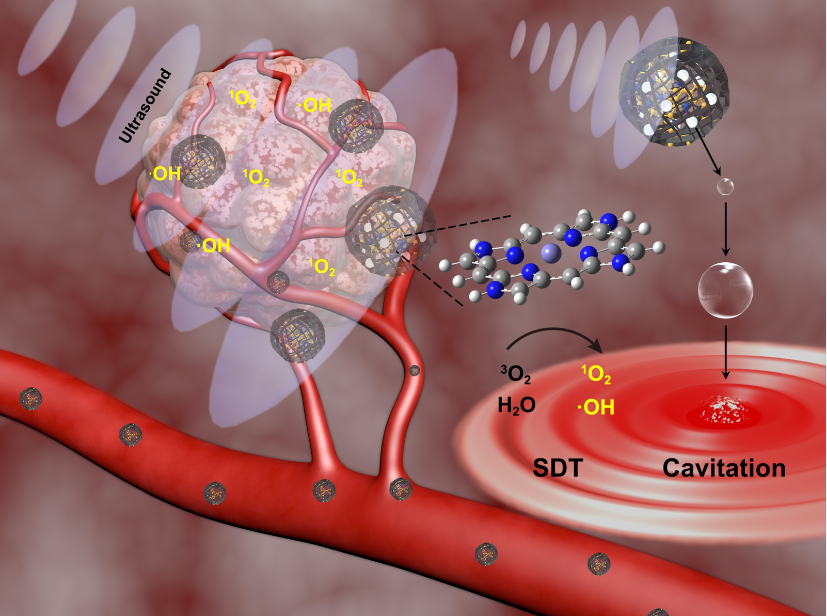Sonodynamic therapy, a novel strategy to attack cancer, has led to widespread interest due to its safety, tissue penetration depth and low cost. Sonodynamic therapy relies on compounds that are activated by a targeted burst of ultrasound, where ultrasound prompt the compounds, known as sonosensitizers, to generate reactive oxygen species that destroy cancer cells in the immediate vicinity without systemic side effects.

Figure 1. Diagram of sonodynamic therapy. (Image by BAI Lixin)
In Sonodynamic therapy, ultrasound can cause irreversible and fatal damage to tumor cells via heat, cavitation, or sonosensitizers, among which the cavitation behavior plays an important role in the sonodynamic therapy.
After investigating the cavitation behaviors of a kind of nitrogen (N)-doped carbon material with zinc-centered porphyrin-like structure, synthesized by high-temperature calcination using ZIF-8 as a template, BAI Lixin, as second author, from Institute of Acoustics of the Chinese Academy of Sciences (IACAS), cooperated with LIU Huiyu and her team from Beijing University of Chemical Technology (BUCT), discovered that the high specific surface area and porous structure of porphyrin-like metal centers (PMCS) make nanoparticles obtain excellent gas adsorption properties, providing more nucleation sites for reducing the cavitation threshold intensity.
Since ultrasound can penetrate deeper into tissue than light, so the strategy, in principle, could treat more inaccessible tumors.
Researchers also first intuitively observed the cavitation bubbles’ growth and collapse with PMCS under ultrasound shooting through a high-speed camera. The number and maximum expanded volume of cavitation bubbles in the PMCS is more than that in the water.
Experimental results showed that PMCS, as sonosensitizers, not only can kill tumor cells by generating unique porphyrin-like structure dependent reactive oxygen species, but also can generate higher sonodynamic therapy efficiency by enhancing the cavitation effect with the increase of cavitation nuclei in PMCS micro/meso-pores.
This work will help to explore the sonodynamic therapy mechanism related to carbon nanostructures and to design inorganic sensitizer with excellent stability.
The paper entitled “Metal-Organic-Framework-Derived Carbon Nanostructure Augmented Sonodynamic Cancer Therapy” was published on Advanced Materials.
Funding for this research came from the National Natural Science Foundation of China (No.5177021361, 51572271 and 11674350), National Basic Research Program of China (973 Program) under Grant No. 2016YFA0201500 and Fundamental Research Funds for the Central Universities (buctrc201610, PYBZ1705).
Reference:
PAN Xueting, BAI Lixin, WANG Hui, WU Qingyuan, WANG Hongyu, LIU Shuang, XU Bolong, SHI Xinghua, LIU Huiyu. Metal-Organic-Framework-Derived Carbon Nanostructure Augmented Sonodynamic Cancer Therapy. Advanced Materials (Epub 2018 Apr 19). DOI: 10.1016/j.ultsonch.2018.02.030.
Contact:
WANG Rongquan
Institute of Acoustics, Chinese Academy of Sciences, 100190 Beijing, China
E-mail: wangrongquan@mail.ioa.ac.cn